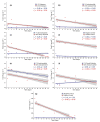Bacterial Utilisation of Aliphatic Organics: Is the Dwarf Planet Ceres Habitable?
- PMID: 35743852
- PMCID: PMC9224870
- DOI: 10.3390/life12060821
Bacterial Utilisation of Aliphatic Organics: Is the Dwarf Planet Ceres Habitable?
Abstract
The regolith environment and associated organic material on Ceres is analogous to environments that existed on Earth 3-4 billion years ago. This has implications not only for abiogenesis and the theory of transpermia, but it provides context for developing a framework to contrast the limits of Earth's biosphere with extraterrestrial environments of interest. In this study, substrate utilisation by the ice-associated bacterium Colwellia hornerae was examined with respect to three aliphatic organic hydrocarbons that may be present on Ceres: dodecane, isobutyronitrile, and dioctyl-sulphide. Following inoculation into a phyllosilicate regolith spiked with a hydrocarbon (1% or 20% organic concentration wt%), cell density, electron transport activity, oxygen consumption, and the production of ATP, NADPH, and protein in C. hornerae was monitored for a period of 32 days. Microbial growth kinetics were correlated with changes in bioavailable carbon, nitrogen, and sulphur. We provide compelling evidence that C. hornerae can survive and grow by utilising isobutyronitrile and, in particular, dodecane. Cellular growth, electron transport activity, and oxygen consumption increased significantly in dodecane at 20 wt% compared to only minor growth at 1 wt%. Importantly, the reduction in total carbon, nitrogen, and sulphur observed at 20 wt% is attributed to biotic, rather than abiotic, processes. This study illustrates that short-term bacterial incubation studies using exotic substrates provide a useful indicator of habitability. We suggest that replicating the regolith environment of Ceres warrants further study and that this dwarf planet could be a valid target for future exploratory missions.
Keywords: Ceres; Colwellia hornerae; aliphatic hydrocarbons; astrobiology.
Conflict of interest statement
The authors declare no conflict of interest.
Figures




Similar articles
-
Planning Implications Related to Sterilization-Sensitive Science Investigations Associated with Mars Sample Return (MSR).Astrobiology. 2022 Jun;22(S1):S112-S164. doi: 10.1089/AST.2021.0113. Epub 2022 May 19. Astrobiology. 2022. PMID: 34904892
-
Extensive water ice within Ceres' aqueously altered regolith: Evidence from nuclear spectroscopy.Science. 2017 Jan 6;355(6320):55-59. doi: 10.1126/science.aah6765. Epub 2016 Dec 15. Science. 2017. PMID: 27980087
-
Organic Material on Ceres: Insights from Visible and Infrared Space Observations.Life (Basel). 2020 Dec 24;11(1):9. doi: 10.3390/life11010009. Life (Basel). 2020. PMID: 33374247 Free PMC article.
-
Beyond the principle of plentitude: a review of terrestrial planet habitability.Astrobiology. 2005 Apr;5(2):100-26. doi: 10.1089/ast.2005.5.100. Astrobiology. 2005. PMID: 15815163 Review.
-
Exploring the Bimodal Solar System via Sample Return from the Main Asteroid Belt: The Case for Revisiting Ceres.Space Sci Rev. 2020;216(4):59. doi: 10.1007/s11214-020-00671-0. Epub 2020 May 18. Space Sci Rev. 2020. PMID: 32624627 Free PMC article. Review.
References
-
- Mbadinga S.M., Wang L.Y., Zhou L., Liu J.F., Gu J.D., Mu B.Z. Microbial communities involved in anaerobic degradation of alkanes. Int. Biodeterior. Biodegrad. 2011;65:1–13. doi: 10.1016/j.ibiod.2010.11.009. - DOI
-
- Gregson B.H., Metodieva G., Metodiev M.V., McKew B.A. Differential protein expression during growth on linear versus branched alkanes in the obligate marine hydrocarbon-degrading bacterium Alcanivorax borkumensis SK2T. Environ. Microbiol. 2019;21:2347–2359. doi: 10.1111/1462-2920.14620. - DOI - PMC - PubMed
Grants and funding
LinkOut - more resources
Full Text Sources

